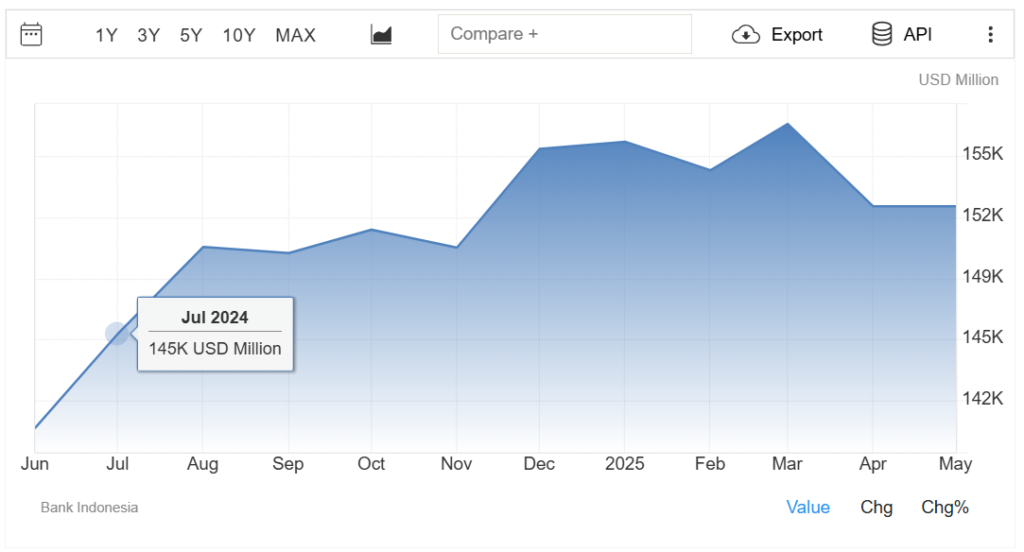BI Forex Intervention in 2025: How Bank Indonesia Responds to Market Shocks with Precision
BI forex intervention: Through the first half of 2025, the global economy has remained anything but calm. Uncertainty in commodity markets, continued rate hikes by advanced economies, and tensions in regional trade flows have all fed into increased pressure on emerging market currencies. The Indonesian rupiah, while not the worst-hit, has seen its share of instability.
In response, BI forex intervention has once again become a central lever in Bank Indonesia’s toolkit. But unlike previous years marked by large-scale USD sales or headline-making announcements, 2025 has seen a more calculated, behind-the-scenes approach. BI is intervening—but it’s doing so with a steadier hand, guided by both market signals and long-term strategy.
BI’s Managed Float: BI forex intervention- More Flexible, Yet Firm

Source: The Diplomat
Indonesia operates under a managed float regime, meaning the rupiah is largely determined by supply and demand, but BI reserves the right to step in when needed. In 2025, this system has allowed the rupiah to adjust naturally to macroeconomic realities while avoiding disorderly swings.
The interventions we’ve seen this year underscore BI’s view: currency movement is healthy, but panic is not. Short-term spikes caused by speculative sentiment—rather than economic fundamentals—are met with timely liquidity support or hedging instruments.
DNDFs and Spot Operations: BI forex intervention- The Evolving Tools of Intervention
One of the clearest trends in 2025 has been Bank Indonesia’s preference for using Domestic Non-Deliverable Forwards (DNDFs) alongside spot market interventions. DNDFs, which allow investors to hedge currency exposure without moving actual cash, have helped BI shape future expectations around the rupiah while minimizing pressure on daily market movements.
Spot transactions are still used—particularly when there’s a surge in USD demand—but they are often quieter and more measured. This dual-tool strategy reflects a more nuanced response to volatility and a deeper focus on market function.
Market Timing: BI Acts Swiftly But Selectively

Source: TradingEconomics
BI’s interventions in 2025 have followed a noticeable pattern: they happen not constantly, but exactly when they’re needed. For instance, in March 2025, as the rupiah faced downward pressure after a surprise Fed decision, BI stepped in with a combination of USD injections and DNDF auctions. The result? A calmer market, improved investor confidence, and no major reserve depletion.
This kind of targeted response has helped set expectations. Market participants understand that BI is watching—and ready—but not looking to micromanage every fluctuation.
Communicating Intervention Without Causing Panic

Another shift in 2025 is how BI is framing its interventions. Rather than issuing dramatic statements, the central bank integrates its currency strategy into broader monetary policy messaging. This subtle yet clear communication helps avoid triggering fears of instability.
For example, BI’s March Monetary Policy Review didn’t specifically announce interventions but highlighted its continued commitment to rupiah stability and inflation control. This reassures markets without putting forex moves under a spotlight that could amplify speculation.
Impact on Inflation and Investment Climate

Source: Business Indonesia
So far in 2025, this intervention strategy appears to be paying off. The rupiah has traded in a relatively stable band, and Indonesia’s inflation rate has remained within the central bank’s target range. More importantly, foreign investor interest in local bonds and equities has not been deterred—suggesting that BI’s currency management is seen as credible rather than controlling.
By striking a careful balance between flexibility and defense, BI is helping create a more predictable environment for trade, investment, and household spending.
What to Watch in the Second Half of 2025
Looking ahead, BI forex intervention is likely to remain a key support mechanism. With global growth still uneven and election-related sentiment brewing at home, the rupiah will face further challenges. However, BI’s trend this year suggests it will continue to use low-key, timely, and data-driven interventions rather than large-scale disruption.
The bank’s ability to adapt—relying more on futures instruments, strengthening reserves, and syncing with fiscal coordination—will determine whether the rupiah remains resilient into 2026.
Conclusion: BI Forex Intervention 2025 Reflects Strategic Maturity, Not Aggression
In a financial landscape shaped by fragility and fast-moving capital, BI forex intervention in 2025 is no longer about bold defense. It’s about balance, timing, and communication. Bank Indonesia has moved from reactive support to strategic calibration—deploying market tools with purpose and precision.
For market watchers, businesses, and ordinary citizens alike, that means one thing: less noise, more clarity. And in a volatile world, that’s a trend worth tracking.




